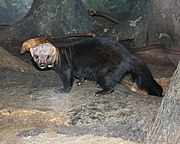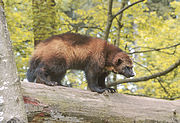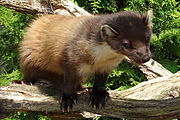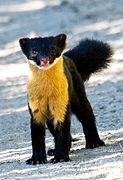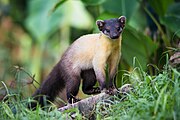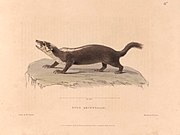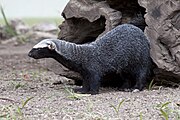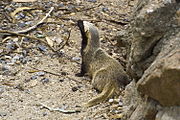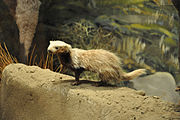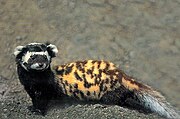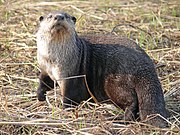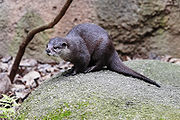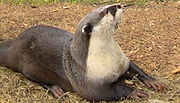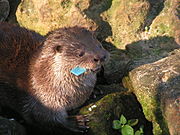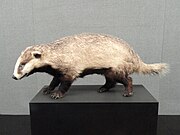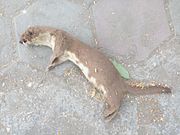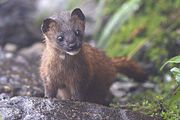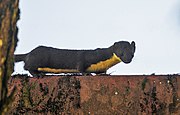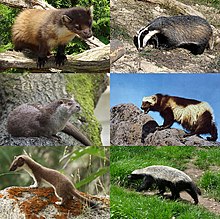
Mustelidae is a family of mammals in the order Carnivora, which includes weasels, badgers, otters, ferrets, martens, minks, and wolverines, and many other extant and extinct genera. A member of this family is called a mustelid; Mustelidae is the largest family in Carnivora, and its extant species are divided into eight subfamilies. They are found on all continents except Antarctica and Australia, and are a diverse family; sizes range, including tails, from the widespread 17 cm (7 in) least weasel to the 1.8-meter (6 ft) giant otter of Amazonian South America. Habitats vary widely as well, from the arboreal marten to the fossorial European badger to the marine sea otter. Population sizes are largely unknown, though two species, the sea mink and Japanese otter, were hunted to extinction in 1894 and 1979, respectively, and several other species are endangered. Some species have been domesticated, e.g. the ferret and some populations of the South American tayra. Mustelidae is one of the oldest families in Carnivora; early mustelids first appeared around 28–33 million years ago.
The 23 genera and 62 extant species of Mustelidae are split into 8 subfamilies: Guloninae, martens and wolverines; Helictidinae, ferret-badgers; Ictonychinae, African polecats and grisons; Lutrinae, otters; Melinae, Eurasian badgers; Mellivorinae, the honey badger; Mustelinae, weasels and minks; and Taxidiinae, the American badger. In addition to the extant subfamilies, Mustelidae includes three extinct subfamilies designated as Leptarctinae, Mustelavinae, and Oligobuninae. Extinct species have also been placed into all of the extant subfamilies besides Helictidinae, in both extant and extinct genera; around 200 extinct Mustelidae species have been found, as well as fossil genera not given a species name, though due to ongoing research and discoveries the exact number and categorization is not fixed.
Conventions
| Conservation status | |
|---|---|
| EX | Extinct (2 species) |
| EW | Extinct in the wild (0 species) |
| CR | Critically Endangered (1 species) |
| EN | Endangered (7 species) |
| VU | Vulnerable (6 species) |
| NT | Near threatened (7 species) |
| LC | Least concern (39 species) |
| Other categories | |
| DD | Data deficient (1 species) |
| NE | Not evaluated (1 species) |
Conservation status codes listed follow the International Union for Conservation of Nature (IUCN) Red List of Threatened Species. Range maps are provided wherever possible; if a range map is not available, a description of the mustelid's range is provided. Ranges are based on the IUCN Red List for that species unless otherwise noted. All extinct species or subspecies listed alongside extant species went extinct after 1500 CE, and are indicated by a dagger symbol "†". Population figures are rounded to the nearest hundred.
Classification
The family Mustelidae consists of 62 extant species belonging to 23 genera and divided into hundreds of extant subspecies, as well the extinct sea mink and Japanese otter, which are the only mustelid species to become extinct since prehistoric times. This does not include hybrid species or extinct prehistoric species. Modern molecular studies indicate that the 23 genera can be grouped into 8 subfamilies. Some prior classification schemes divided the family solely between the aquatic otters and all other species.
Subfamily Guloninae (Martens and wolverines)
- Genus Eira: one species
- Genus Gulo: one species
- Genus Martes: seven species
- Genus Pekania: one species
Subfamily Helictidinae (Ferret-badgers)
- Genus Melogale: five species
Subfamily Ictonychinae (African polecats and grisons)
- Genus Galictis: two species
- Genus Ictonyx: two species
- Genus Lyncodon: one species
- Genus Poecilogale: one species
- Genus Vormela: one species
Subfamily Lutrinae (Otters)
- Genus Aonyx: three species
- Genus Enhydra: one species
- Genus Hydrictis: one species
- Genus Lontra: four species
- Genus Lutra: three species
- Genus Lutrogale: one species
- Genus Pteronura: one species
Subfamily Melinae (Eurasian badgers)
Subfamily Mellivorinae (Honey badger)
- Genus Mellivora: one species
Subfamily Mustelinae (Weasels and minks)
Subfamily Taxidiinae (American badger)
- Genus Taxidea: one species
Mustelids
The following classification is based on the taxonomy described by Mammal Species of the World (2005), with augmentation by generally accepted proposals made since using molecular phylogenetic analysis; this includes reclassifying Guloninae, Helictidinae, Ictonychinae, Melinae, Mellivorinae, and Taxidiinae as subfamilies rather than as part of a paraphyletic group with Mustelinae
Subfamily Guloninae
Main article: Guloninae| Common name | Scientific name and subspecies | Range | Size and ecology | IUCN status and estimated population |
|---|---|---|---|---|
| Tayra | E. barbara (Linnaeus, 1758) Seven subspecies
|
Central America, Trinidad in the Caribbean, and northern South America
|
Size: 60–70 cm (24–28 in) long, plus 35–45 cm (14–18 in) tail Habitat: Forest and savanna Diet: Primarily eats fruit, carrion, small vertebrates, insects, and honey |
LC
|
| Common name | Scientific name and subspecies | Range | Size and ecology | IUCN status and estimated population |
|---|---|---|---|---|
| Wolverine | G. gulo (Linnaeus, 1758) Two subspecies
|
Arctic North America, Europe, and Asia
|
Size: 70–105 cm (28–41 in) long, plus 18–26 cm (7–10 in) tail Habitat: Rocky areas, shrubland, forest, and grassland Diet: Primarily eats carrion and small to large mammals |
LC
|
| Common name | Scientific name and subspecies | Range | Size and ecology | IUCN status and estimated population |
|---|---|---|---|---|
| American marten | M. americana (Turton, 1806) Fourteen subspecies
|
Northern North America (includes range of Pacific marten)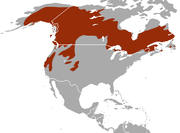
|
Size: 46–66 cm (18–26 in) long, plus 13–16 cm (5–6 in) tail Habitat: Forest Diet: Primarily eats rodents and small mammals, as well as birds, insects, fruit, and carrion |
LC
|
| Beech marten | M. foina (Erxleben, 1777) Eleven subspecies
|
Europe and central Asia
|
Size: 40–50 cm (16–20 in) long, plus 22–30 cm (9–12 in) tail Habitat: Forest, rocky areas, and shrubland Diet: Primarily eats rodents and small mammals, as well as birds, insects, fruit, and carrion |
LC
|
| European pine marten | M. martes (Linnaeus, 1758) Seven subspecies
|
Europe and west Asia
|
Size: 48–58 cm (19–23 in) long, plus 16–28 cm (6–11 in) tail Habitat: Forest and shrubland Diet: Primarily eats small mammals, birds, and amphibians, as well as carrion |
LC
|
| Japanese marten | M. melampus (Wagner, 1841) Two subspecies
|
Japan (M. m. melampus in green, M. m. tsuensis in red (Tsushima Island))
|
Size: 47–55 cm (19–22 in) long, plus 17–22 cm (7–9 in) tail Habitat: Forest and shrubland Diet: Primarily eats fruit, small mammals, and insects |
LC
|
| Nilgiri marten | M. gwatkinsii Horsfield, 1851 |
Parts of southern India
|
Size: 55–65 cm (22–26 in) long, plus 40–45 cm (16–18 in) tail Habitat: Forest and grassland Diet: Primarily eats birds, small mammals, and insects |
VU
|
| Sable | M. zibellina (Linnaeus, 1758) Sixteen subspecies
|
Large parts of Russia
|
Size: 38–56 cm (15–22 in) long, plus 9–12 cm (4–5 in) tail Habitat: Forest Diet: Primarily eats small mammals, birds, nuts, and berries |
LC
|
| Yellow-throated marten | M. flavigula (Boddaert, 1785) Nine subspecies
|
Eastern and southeastern Asia
|
Size: 50–72 cm (20–28 in) long, plus 33–48 cm (13–19 in) tail Habitat: Forest and grassland Diet: Primarily eats birds, small mammals, and insects |
LC
|
| Common name | Scientific name and subspecies | Range | Size and ecology | IUCN status and estimated population |
|---|---|---|---|---|
| Fisher | P. pennanti (Erxleben, 1777) |
Northern North America
|
Size: 75–120 cm (30–47 in) long, plus 31–41 cm (12–16 in) tail Habitat: Forest Diet: Primarily eats small to medium mammals, birds, and carrion |
LC
|
Subfamily Helictidinae
Main article: Helictidinae| Common name | Scientific name and subspecies | Range | Size and ecology | IUCN status and estimated population |
|---|---|---|---|---|
| Bornean ferret-badger
|
M. everetti (Thomas, 1895) |
Small parts of Borneo
|
Size: 33–44 cm (13–17 in) long, plus 15–23 cm (6–9 in) tail Habitat: Forest and shrubland Diet: Primarily eats invertebrates, amphibians, insects, fruit, and carrion |
EN
|
| Burmese ferret-badger | M. personata I. Saint-Hilaire, 1831 Five subspecies
|
Southeast Asia
|
Size: 33–44 cm (13–17 in) long, plus 15–23 cm (6–9 in) tail Habitat: Grassland, shrubland, and forest Diet: Primarily eats insects and snails, as well as small mammals, frogs, lizards, carrion, birds, eggs, and fruit |
LC
|
| Chinese ferret-badger | M. moschata (Gray, 1831) Seven subspecies
|
East Asia
|
Size: 30–43 cm (12–17 in) long, plus 15–21 cm (6–8 in) tail Habitat: Forest, shrubland, and grassland Diet: Primarily eats insects, frogs, and carrion |
LC
|
| Javan ferret-badger | M. orientalis (Blanford, 1888) Two subspecies
|
Parts of Java and Indonesia
|
Size: 35–40 cm (14–16 in) long, plus 14–17 cm (6–7 in) tail Habitat: Shrubland and forest Diet: Primarily eats invertebrates and insects |
LC
|
| Vietnam ferret-badger
|
M. cucphuongensis T. Nadler, 2011 |
Vietnam | Size: Unknown Habitat: Forest Diet: Unknown |
DD
|
Subfamily Ictonychinae
Main article: Ictonychinae| Common name | Scientific name and subspecies | Range | Size and ecology | IUCN status and estimated population |
|---|---|---|---|---|
| Greater grison | G. vittata (Schreber, 1776) Four subspecies
|
Northern South America and Central America
|
Size: 60–76 cm (24–30 in) long, including tail Habitat: Forest and grassland Diet: Primarily eats small mammals, birds, lizards, amphibians, eggs, and fruit |
LC
|
| Lesser grison | G. cuja (Molina, 1782) Four subspecies
|
Southern South America
|
Size: 28–51 cm (11–20 in) long, plus 12–20 cm (5–8 in) tail Habitat: Inland wetlands, forest, grassland, and savanna Diet: Primarily eats small lagomorphs and rodents, as well as birds, frogs, lizards, snakes, and eggs |
LC
|
| Common name | Scientific name and subspecies | Range | Size and ecology | IUCN status and estimated population |
|---|---|---|---|---|
| Striped polecat | I. striatus (Molina, 1782) Nineteen subspecies
|
Central, Southern, and sub-Saharan Africa
|
Size: 28–30 cm (11–12 in) long, plus 20–30 cm (8–12 in) tail Habitat: Grassland, savanna, desert, and shrubland Diet: Primarily eats insects |
LC
|
| Saharan striped polecat | I. libycus (Hemprich and Ehrenberg, 1833) Four subspecies
|
Northern, western, and southern edges of the Sahara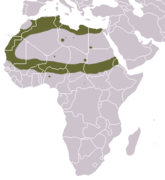
|
Size: 40–47 cm (16–19 in) long, plus 16–19 cm (6–7 in) tail Habitat: Shrubland and desert Diet: Primarily eats rodents, small mammals, birds, fish, and insects |
LC
|
| Common name | Scientific name and subspecies | Range | Size and ecology | IUCN status and estimated population |
|---|---|---|---|---|
| Patagonian weasel | L. patagonicus (Blainville, 1842) Two subspecies
|
Argentina
|
Size: 30–35 cm (12–14 in) long, plus 6–9 cm (2–4 in) tail Habitat: Shrubland, grassland, and forest Diet: Primarily eats rodents and birds |
LC
|
| Common name | Scientific name and subspecies | Range | Size and ecology | IUCN status and estimated population |
|---|---|---|---|---|
| African striped weasel | P. albinucha (Gray, 1864) Five subspecies
|
Southern Africa
|
Size: 25–36 cm (10–14 in) long, plus 13–23 cm (5–9 in) tail Habitat: Shrubland, forest, savanna, and grassland Diet: Primarily eats small mammals, rodents, and birds, as well as snakes and insects |
LC
|
| Common name | Scientific name and subspecies | Range | Size and ecology | IUCN status and estimated population |
|---|---|---|---|---|
| Marbled polecat | V. peregusna (Güldenstädt, 1864) Five subspecies
|
Southeast Europe and central Asia
|
Size: 28–48 cm (11–19 in) long, plus 14–20 cm (6–8 in) tail Habitat: Desert, rocky areas, grassland, and shrubland Diet: Primarily eats rodents and birds |
VU
|
Subfamily Lutrinae
Main article: Lutrinae| Common name | Scientific name and subspecies | Range | Size and ecology | IUCN status and estimated population |
|---|---|---|---|---|
| African clawless otter | A. capensis Schinz, 1821 Five subspecies
|
Sub-Saharan Africa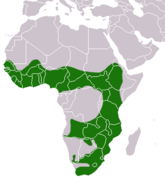
|
Size: 72–95 cm (28–37 in) long, plus 40–60 cm (16–24 in) tail Habitat: Forest, inland wetlands, neritic marine, coastal marine, intertidal marine, and grassland Diet: Primarily eats crabs and lobsters, as well as frogs, fish, and insects |
NT
|
| Asian small-clawed otter | A. cinereus (Illiger, 1815) Three subspecies
|
Southeast Asia
|
Size: 40–63 cm (16–25 in) long, plus 25–35 cm (10–14 in) tail Habitat: Intertidal marine, coastal marine, inland wetlands, forest, shrubland, neritic marine, and grassland Diet: Primarily eats crabs, molluscs, insects, and small fish, as well as rodents, snakes, and amphibians |
VU
|
| Congo clawless otter | A. congicus (Lönnberg, 1910) |
Sub-Saharan Africa
|
Size: 79–95 cm (31–37 in) long, plus 50–56 cm (20–22 in) tail Habitat: Forest, inland wetlands, and marine Diet: Unknown |
NT
|
| Common name | Scientific name and subspecies | Range | Size and ecology | IUCN status and estimated population |
|---|---|---|---|---|
| Sea otter | E. lutris (Linnaeus, 1758) Three subspecies
|
Northern Pacific coasts
|
Size: 55–130 cm (22–51 in) long, plus 12–33 cm (5–13 in) tail Habitat: Neritic marine and oceanic marine Diet: Primarily eats marine invertebrates, as well as fish |
EN
|
| Common name | Scientific name and subspecies | Range | Size and ecology | IUCN status and estimated population |
|---|---|---|---|---|
| Spotted-necked otter | H. maculicollis (Lichtenstein, 1835) |
Much of sub-Saharan Africa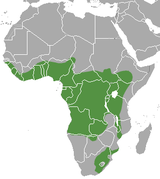
|
Size: 57–69 cm (22–27 in) long, plus 33–44 cm (13–17 in) tail Habitat: Inland wetlands, neritic marine, forest, coastal marine, and intertidal marine Diet: Primarily eats frogs, crabs and small water birds |
NT
|
| Common name | Scientific name and subspecies | Range | Size and ecology | IUCN status and estimated population |
|---|---|---|---|---|
| North American river otter | L. canadensis (Schreber, 1777) Seven subspecies
|
United States and Canada, possibly Mexico
|
Size: 66–107 cm (26–42 in) long, plus 31–46 cm (12–18 in) tail Habitat: Inland wetlands, intertidal marine, neritic marine, and coastal marine Diet: Primarily eats fish, as well as amphibians and crustaceans |
LC
|
| Southern river otter | L. provocax (Thomas, 1908) |
Southern Chile and Argentina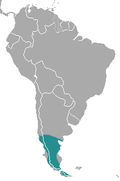
|
Size: 57–70 cm (22–28 in) long, plus 35–46 cm (14–18 in) tail Habitat: Inland wetlands, coastal marine, neritic marine, and intertidal marine Diet: Primarily eats fish and crustaceans |
EN
|
| Neotropical otter | L. longicaudis (Olfers, 1818) Three subspecies
|
South and Central America, Trinidad in the Caribbean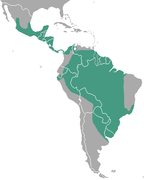
|
Size: 50–79 cm (20–31 in) long, plus 37–57 cm (15–22 in) tail Habitat: Coastal marine, inland wetlands, neritic marine, and intertidal marine Diet: Primarily eats fish, as well as crustaceans, insects, amphibians, and molluscs |
NT
|
| Marine otter | L. felina (Molina, 1782) |
West coast of South America
|
Size: 57–79 cm (22–31 in) long, plus 30–36 cm (12–14 in) tail Habitat: Coastal marine, intertidal marine, oceanic marine, and neritic marine Diet: Primarily eats crustaceans and molluscs, as well as fish, birds, and small mammals |
EN
|
| Common name | Scientific name and subspecies | Range | Size and ecology | IUCN status and estimated population |
|---|---|---|---|---|
| Eurasian otter | L. lutra (Linnaeus, 1758) Eleven subspecies
|
Europe, North Africa, and large regions of Asia
|
Size: 57–70 cm (22–28 in) long, plus 35–40 cm (14–16 in) tail Habitat: Inland wetlands, forest, grassland, coastal marine, neretic marine, intertidal marine, and shrubland Diet: Primarily eats fish, as well as insects, reptiles, amphibians, birds, small mammals, and crustaceans |
NT
|
| Hairy-nosed otter | L. sumatrana (Gray, 1865) |
Scattered parts of southeast Asia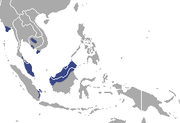
|
Size: 50–82 cm (20–32 in) long, plus 35–50 cm (14–20 in) tail Habitat: Inland wetlands, neritic marine, shrubland, grassland, forest, coastal marine, and intertidal marine Diet: Primarily eats fish and water snakes, as well as frogs, lizards, turtles, and crabs |
EN
|
| Japanese otter† | L. nippon Imaizumi, Yoshiyuki, 1989 |
formerly Japan (extinct) | Size: 65–80 cm (26–31 in) long, plus 45–50 cm (18–20 in) tail Habitat: Inland wetlands, neritic marine, shrubland, grassland, forest, coastal marine, and intertidal marine Diet: Fish, crabs, shrimp, eels, beetles, fruit |
EX
|
| Common name | Scientific name and subspecies | Range | Size and ecology | IUCN status and estimated population |
|---|---|---|---|---|
| Smooth-coated otter | L. perspicillata Geoffroy Saint-Hilaire, 1826 Three subspecies
|
Iraq, South and southeast Asia
|
Size: 65–79 cm (26–31 in) long, plus 40–50 cm (16–20 in) tail Habitat: Inland wetlands, forest, grassland, coastal marine, neritic marine, intertidal marine, and shrubland Diet: Primarily eats fish, as well as shrimp, crabs, and insects |
VU
|
| Common name | Scientific name and subspecies | Range | Size and ecology | IUCN status and estimated population |
|---|---|---|---|---|
| Giant otter | P. brasiliensis (Gmelin, 1788) Two subspecies
|
North and central South America
|
Size: 96–123 cm (38–48 in) long, plus 45–65 cm (18–26 in) tail Habitat: Inland wetlands, coastal marine, neritic marine, and forest Diet: Primarily eats fish, as well as caiman and turtles |
EN
|
Subfamily Melinae
Main article: Melinae| Common name | Scientific name and subspecies | Range | Size and ecology | IUCN status and estimated population |
|---|---|---|---|---|
| Greater hog badger | A. collaris F. Cuvier, 1825 Four subspecies
|
East and southeast Asia (image includes albogularis and hoevenii)
|
Size: 65–104 cm (26–41 in) long, plus 19–29 cm (7–11 in) tail Habitat: Forest, grassland, shrubland, and savanna Diet: Believed to primarily eat worms |
VU
|
| Northern hog badger | A. albogularis (Blyth, 1853) Two subspecies
|
South and East Asia (image includes collaris and hoevenii)
|
Size: 55–70 cm (22–28 in) long, plus 11–22 cm (4–9 in) tail Habitat: Forest, bushland, agricultural area, wasteland, and montane grassland Diet: Small vertebrates, invertebrates, and plant material |
LC
|
| Sumatran hog badger
|
A. hoevenii (Blyth, 1853) |
Sumatra | Size: 51–71 cm (20–28 in) long, plus 8–18 cm (3–7 in) tail Habitat: Montane and mossy forests, montane grasslands Diet: Believed to primarily eat invertebrates |
LC
|
| Common name | Scientific name and subspecies | Range | Size and ecology | IUCN status and estimated population |
|---|---|---|---|---|
| Asian badger | M. leucurus (Hodgson, 1847) Five subspecies
|
Central and east Asia
|
Size: 49–70 cm (19–28 in) long, plus 13–21 cm (5–8 in) tail Habitat: Shrubland, grassland, and forest Diet: Omnivorous; eats fruit, nuts, plants, earthworms, insects, eggs, carrion, and small mammals |
LC
|
| European badger | M. meles (Linnaeus, 1758) Four subspecies
|
Europe (map also includes range of Caucasian badger)
|
Size: 56–90 cm (22–35 in) long, plus 11–20 cm (4–8 in) tail Habitat: Grassland, forest, desert, and shrubland Diet: Omnivorous; eats fruit, nuts, plants, earthworms, insects, eggs, carrion, and small mammals |
LC
|
| Japanese badger | M. anakuma Temminck, 1844 |
Japan
|
Size: 70–79 cm (28–31 in) long, plus 14–20 cm (6–8 in) tail Habitat: Forest Diet: Primarily eats earthworms and insects, as well as fruit |
LC
|
Subfamily Mellivorinae
Main article: Mellivorinae| Common name | Scientific name and subspecies | Range | Size and ecology | IUCN status and estimated population |
|---|---|---|---|---|
| Honey badger | M. capensis (Schreber, 1776) Twelve subspecies
|
Africa, Middle East, and India
|
Size: 73–96 cm (29–38 in) long, plus 14–23 cm (6–9 in) tail Habitat: Forest, shrubland, savanna, and desert Diet: Primarily eats smaller mammals |
LC
|
Subfamily Mustelinae
Main article: Mustelinae| Common name | Scientific name and subspecies | Range | Size and ecology | IUCN status and estimated population |
|---|---|---|---|---|
| Back-striped weasel | M. strigidorsa Gray, 1855 |
Parts of southeast Asia
|
Size: 30–36 cm (12–14 in) long, plus 18–20 cm (7–8 in) tail Habitat: Forest and shrubland Diet: Unknown, but believed to eat rodents and insects |
LC
|
| Black-footed ferret | M. nigripes (Audubon, 1851) |
Three small areas in central United States
|
Size: 50–53 cm (20–21 in) long, plus 11–13 cm (4–5 in) tail Habitat: Shrubland and grassland Diet: Primarily eats prairie dogs |
EN
|
| Egyptian weasel | M. subpalmata Hemprich, 1833 |
Nile river delta in Egypt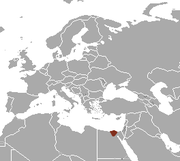
|
Size: 32–43 cm (13–17 in) long, plus 9–13 cm (4–5 in) tail Habitat: Urban, marine Diet: Primarily eats fruit and vegetables, birds, and insects |
LC
|
| European mink | M. lutreola (Linnaeus, 1761) Seven subspecies
|
Scattered parts of west Asia and west Europe
|
Size: 35–43 cm (14–17 in) long, plus 15–19 cm (6–7 in) tail Habitat: Inland wetlands Diet: Primarily eats amphibians, crustaceans, fish, small mammals, insects, and birds |
CR
|
| European polecat | M. putorius Linnaeus, 1758 Six subspecies
|
Europe and west Asia
|
Size: 29–46 cm (11–18 in) long, plus 8–17 cm (3–7 in) tail Habitat: Inland wetlands, coastal marine, grassland, forest, and shrubland Diet: Primarily eats lagomorphs, rodents, amphibians, and other vertebrates, as well as invertebrates and carrion |
LC
|
| Ferret | M. furo Linnaeus, 1758 |
Worldwide distribution (domesticated) | Size: 20–46 cm (8–18 in) long, plus 7–19 cm (3–7 in) tail Habitat: Domesticated Diet: Primarily eats small mammals |
NE
|
| Indonesian mountain weasel
|
M. lutreolina Robinson, 1917 |
Scattered parts of Indonesia
|
Size: 27–33 cm (11–13 in) long, plus 13–17 cm (5–7 in) tail Habitat: Shrubland and forest Diet: Primarily eats rodents, as well as small mammals, birds, amphibians, and eggs |
LC
|
| Japanese weasel | M. itatsi Temminck, 1844 |
native to Japan, introduced to Russia (native range in blue, introduced in red (Hokkaido, Sakhalin))
|
Size: 21–36 cm (8–14 in) long, plus 7–16 cm (3–6 in) tail Habitat: Shrubland, grassland, and forest Diet: Primarily eats rodents, insects, amphibians, and reptiles |
NT
|
| Least weasel | M. nivalis Linnaeus, 1766 Seventeen subspecies
|
Europe, Asia, northern Africa, northern North America
|
Size: 11–26 cm (4–10 in) long, plus 1–9 cm (0–4 in) tail Habitat: Forest, inland wetlands, rocky areas, coastal marine, shrubland, and grassland Diet: Primarily eats rodents and other small mammals as well as eggs, lizards, frogs, salamanders, fish, worms, and carrion |
LC
|
| Malayan weasel
|
M. nudipes Desmarest, 1822 Two subspecies
|
Southeast Asia
|
Size: 30–36 cm (12–14 in) long, plus 24–26 cm (9–10 in) tail Habitat: Shrubland and forest Diet: Primarily eats rodents, as well as small birds, lizards, and insects |
LC
|
| Mountain weasel | M. altaica Pallas, 1811 Four subspecies
|
Central Asia and northern India | Size: 22–29 cm (9–11 in) long, plus 9–15 cm (4–6 in) tail Habitat: Shrubland, rocky areas, and grassland Diet: Primarily eats pikas, rodents, small birds, lizards, and insects |
NT
|
| Siberian weasel | M. sibirica Pallas, 1773 Eleven subspecies
|
North-central and east Asia (native range in green, introduced in red (Japan))
|
Size: 25–39 cm (10–15 in) long, plus 13–21 cm (5–8 in) tail Habitat: Grassland, shrubland, forest, and rocky areas Diet: Primarily eats small mammals, amphibians, fish, carrion, and pine nuts |
LC
|
| Steppe polecat | M. eversmanii Lesson, 1827 Seven subspecies
|
Central Asia and eastern Europe
|
Size: 29–56 cm (11–22 in) long, plus 8–18 cm (3–7 in) tail Habitat: Grassland and shrubland Diet: Primarily eats rodents and pikas |
LC
|
| Stoat | M. erminea Linnaeus, 1758 37 subspecies
|
Europe, north Asia, northern North America, and Greenland (native range in green, introduced in red (New Zealand)); map includes range of American and haida ermines
|
Size: 17–33 cm (7–13 in) long, plus 4–12 cm (2–5 in) tail Habitat: Shrubland, inland wetlands, grassland, rocky areas, and forest Diet: Primarily eats small mammals, as well as fruit, earthworms, insects, eggs, and birds |
LC
|
| Yellow-bellied weasel | M. kathiah Hodgson, 1835 Two subspecies
|
Himalayan mountains and east-southeast Asia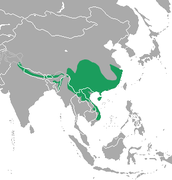
|
Size: 25–27 cm (10–11 in) long, plus 12–15 cm (5–6 in) tail Habitat: Forest, shrubland, and grassland Diet: Primarily eats rodents, as well as birds and small mammals |
LC
|
| Common name | Scientific name and subspecies | Range | Size and ecology | IUCN status and estimated population |
|---|---|---|---|---|
| Amazon weasel
|
N. africana (Desmarest, 1818) Two subspecies
|
Amazon basin
|
Size: 41–52 cm (16–20 in) long, plus 16–21 cm (6–8 in) tail Habitat: Inland wetlands and forest Diet: Unknown |
LC
|
| American mink | N. vison (Schreber, 1777) Fifteen subspecies
|
Canada and United States; introduced to large areas in South America, Europe, and Asia (native range in red (North America), introduced in pink)
|
Size: 31–45 cm (12–18 in) long, plus 14–25 cm (6–10 in) tail Habitat: Inland wetlands, forest, and shrubland Diet: Primarily eats fish, amphibians, crustaceans, muskrats, and small mammals |
LC
|
| Colombian weasel
|
N. felipei (Izor and Torre, 1978) |
Small area of northwest South America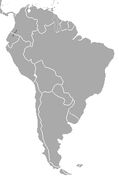
|
Size: 32–39 cm (13–15 in) long, plus 10–14 cm (4–6 in) tail Habitat: Inland wetlands and forest Diet: Unknown, but believed to eat fish, small mammals, and insects |
VU
|
| Long-tailed weasel | N. frenata (Lichtenstein, 1831) 42 subspecies
|
North America, Central America, and northern South America
|
Size: 28–42 cm (11–17 in) long, plus 11–30 cm (4–12 in) tail Habitat: Inland wetlands, grassland, and shrubland Diet: Primarily eats rodents and other small mammals |
LC
|
| Sea mink†
|
N. macrodon (Prentiss, 1903) |
formerly northern New England coast in United States, Maritime Provinces in Canada
|
Size: Estimated to have been around 91 cm (36 in) long, plus 25 cm (10 in) tail Habitat: Intertidal marine, neritic marine, and coastal marine Diet: Primarily ate fish as well as molluscs |
EX
|
Subfamily Taxidiinae
Main article: Taxidiinae| Common name | Scientific name and subspecies | Range | Size and ecology | IUCN status and estimated population |
|---|---|---|---|---|
| American badger | T. taxus (Schreber, 1777) Five subspecies
|
Mexico, United States and southern Canada
|
Size: 42–72 cm (17–28 in) long, plus 10–16 cm (4–6 in) tail Habitat: Forest, grassland, and shrubland Diet: Primarily eats fossorial rodents, as well as scorpions, insects, snakes, lizards, and birds |
LC
|
References
- Law, C. J.; Slater, G. J.; Mehta, R. S. (January 2018). "Lineage Diversity and Size Disparity in Musteloidea: Testing Patterns of Adaptive Radiation Using Molecular and Fossil-Based Methods". Systematic Biology. 67 (1): 127–144. doi:10.1093/sysbio/syx047. PMID 28472434.
- Schreffler, Christina (2003). "Eira barbara". Animal Diversity Web. University of Michigan. Retrieved November 13, 2019.
- ^ Cuarón, A. D.; Reid, F.; Helgen, K.; González-Maya, J. F. (2016). "Eira barbara". IUCN Red List of Threatened Species. 2016: e.T41644A45212151. doi:10.2305/IUCN.UK.2016-1.RLTS.T41644A45212151.en.
- Streubel, Donald (2000). "Wolverine". Digital Atlas of Idaho. Idaho State University. Archived from the original on August 22, 2016. Retrieved October 2, 2019.
- ^ Abramov, A. V. (2016). "Gulo gulo". IUCN Red List of Threatened Species. 2016: e.T9561A45198537. doi:10.2305/IUCN.UK.2016-1.RLTS.T9561A45198537.en.
- Streubel, Donald (2000). "American Marten". Digital Atlas of Idaho. Idaho State University. Archived from the original on August 22, 2016. Retrieved October 2, 2019.
- ^ Helgen, K.; Reid, F. (2016). "Martes americana". IUCN Red List of Threatened Species. 2016: e.T41648A45212861. doi:10.2305/IUCN.UK.2016-1.RLTS.T41648A45212861.en.
- Carter, Kimberlee (2004). "Martes foina". Animal Diversity Web. University of Michigan. Retrieved November 13, 2019.
- ^ Abramov, A. V.; Kranz, A.; Herrero, J.; Choudhury, A.; Maran, T. (2016). "Martes foina". IUCN Red List of Threatened Species. 2016: e.T29672A45202514. doi:10.2305/IUCN.UK.2016-1.RLTS.T29672A45202514.en.
- Schwanz, Lisa (2000). "Martes martes". Animal Diversity Web. University of Michigan. Retrieved November 13, 2019.
- ^ Herrero, J.; Kranz, A.; Skumatov, D.; Abramov, A. V.; Maran, T.; Monakhov, V. G. (2016). "Martes martes". IUCN Red List of Threatened Species. 2016: e.T12848A45199169. doi:10.2305/IUCN.UK.2016-1.RLTS.T12848A45199169.en.
- Barthen, Bill (2003). "Martes melampus". Animal Diversity Web. University of Michigan. Retrieved November 13, 2019.
- ^ Abramov, A. V.; Kaneko, Y.; Masuda, R. (2015). "Martes melampus". IUCN Red List of Threatened Species. 2015: e.T41650A45213228. doi:10.2305/IUCN.UK.2015-4.RLTS.T41650A45213228.en.
- Webb, Amanda (2013). "Martes gwatkinsii". Animal Diversity Web. University of Michigan. Retrieved November 13, 2019.
- ^ Mudappa, D.; Jathana, D.; Raman, T. R. S. (2015). "Martes gwatkinsii". IUCN Red List of Threatened Species. 2015: e.T12847A45199025. doi:10.2305/IUCN.UK.2015-4.RLTS.T12847A45199025.en.
- Bates, Jeremy (2002). "Martes zibellina". Animal Diversity Web. University of Michigan. Retrieved November 13, 2019.
- ^ Monakhov, V. G. (2016). "Martes zibellina". IUCN Red List of Threatened Species. 2016: e.T41652A45213477. doi:10.2305/IUCN.UK.2016-1.RLTS.T41652A45213477.en.
- Shak, Marcus (2012). "Martes flavigula". Animal Diversity Web. University of Michigan. Retrieved November 13, 2019.
- ^ Chutipong, W.; Duckworth, J. W.; Timmins, R. J.; Choudhury, A.; Abramov, A. V.; Roberton, S.; Long, B.; Rahman, H.; Hearn, A.; Dinets, V.; Willcox, D. H. A. (2016). "Martes flavigula". IUCN Red List of Threatened Species. 2016: e.T41649A45212973. doi:10.2305/IUCN.UK.2016-1.RLTS.T41649A45212973.en.
- Rhines, Cynthia (2003). "Martes pennanti". Animal Diversity Web. University of Michigan. Retrieved October 15, 2019.
- ^ Helgen, K.; Reid, F. (2016) . "Martes pennanti". IUCN Red List of Threatened Species. 2016: e.T41651A125236220. doi:10.2305/IUCN.UK.2016-2.RLTS.T41651A125236220.en.
- ^ Edmison, Nicole (2003). "Melogale everetti". Animal Diversity Web. University of Michigan. Retrieved November 13, 2019.
- ^ Wilting, A.; Duckworth, J. W.; Hearn, A.; Ross, J. (2015). "Melogale everetti". IUCN Red List of Threatened Species. 2015: e.T13110A45199541. doi:10.2305/IUCN.UK.2015-4.RLTS.T13110A45199541.en.
- ^ Clarke, Rosie (2003). "Melogale personata". Animal Diversity Web. University of Michigan. Retrieved November 13, 2019.
- ^ Duckworth, J. W.; Long, B.; Willcox, D. H. A.; Coudrat, C. N. Z.; Timmins, R. J.; Abramov, A. V.; Chan, B.; Chutipong, W. (2016). "Melogale personata". IUCN Red List of Threatened Species. 2016: e.T41627A45209826. doi:10.2305/IUCN.UK.2016-1.RLTS.T41627A45209826.en.
- Smith, Andrew T.; Xie, Yan, eds. (2010). A Guide to the Mammals of China. Princeton University Press. p. 441. ISBN 978-1-4008-3411-2.
- ^ Duckworth, J. W.; Abramov, A. V.; Willcox, D. H. A.; Timmins, R. J.; Choudhury, A.; Roberton, S.; Long, B.; Lau, M. (2016). "Melogale moschata". IUCN Red List of Threatened Species. 2016: e.T41626A45209676. doi:10.2305/IUCN.UK.2016-1.RLTS.T41626A45209676.en.
- ^ Denryter, Kristin (2013). "Melogale orientalis". Animal Diversity Web. University of Michigan. Retrieved November 13, 2019.
- ^ Duckworth, J. W.; Shepherd, C.; Rode-Margono, E. J.; Wilianto, E.; Spaan, D.; Abramov, A. V. (2016). "Melogale orientalis". IUCN Red List of Threatened Species. 2016: e.T41697A45218557. doi:10.2305/IUCN.UK.2016-1.RLTS.T41697A45218557.en.
- ^ Helgen, K.; Long, B. (2016). "Melogale cucphuongensis". IUCN Red List of Threatened Species. 2016: e.T68369199A68369432. doi:10.2305/IUCN.UK.2016-1.RLTS.T68369199A68369432.en.
- Gregg, Mackenzie (2013). "Galictis grison". Animal Diversity Web. University of Michigan. Retrieved November 21, 2019.
- ^ Cuarón, A. D.; Reid, F.; González-Maya, J. F.; Helgen, K. (2016). "Galictis vittata". IUCN Red List of Threatened Species. 2016: e.T41640A45211961. doi:10.2305/IUCN.UK.2016-1.RLTS.T41640A45211961.en.
- Melrose, Robert (2004). "Galictis cuja". Animal Diversity Web. University of Michigan. Retrieved November 21, 2019.
- ^ Helgen, K.; Schiaffini, M. (2016). "Galictis cuja". IUCN Red List of Threatened Species. 2016: e.T41639A45211832. doi:10.2305/IUCN.UK.2016-1.RLTS.T41639A45211832.en.
- Aguilar, William (2003). "Ictonyx striatus". Animal Diversity Web. University of Michigan. Retrieved November 21, 2019.
- ^ Stuart, C.; Stuart, M.; Do Linh San, E. (2015). "Ictonyx striatus". IUCN Red List of Threatened Species. 2015: e.T41646A45212491. doi:10.2305/IUCN.UK.2015-4.RLTS.T41646A45212491.en.
- ^ Hoath, Richard (2009). A Field Guide to the Mammals of Egypt. American University in Cairo Press. pp. 82–84. ISBN 978-9774162541.
- ^ Ahmim, M.; Do Linh San, E. (2015). "Ictonyx libycus". IUCN Red List of Threatened Species. 2015: e.T41645A45212347. doi:10.2305/IUCN.UK.2015-4.RLTS.T41645A45212347.en.
- Malek, Karen (2003). "Lyncodon patagonicus". Animal Diversity Web. University of Michigan. Retrieved November 21, 2019.
- ^ Kelt, D.; Pardiñas, U.; Schiaffini, M.; González-Maya, J. F. (2016). "Lyncodon patagonicus". IUCN Red List of Threatened Species. 2016: e.T41647A45212747. doi:10.2305/IUCN.UK.2016-1.RLTS.T41647A45212747.en.
- ^ Brilliant, Matt (2000). "Poecilogale albinucha". Animal Diversity Web. University of Michigan. Retrieved November 21, 2019.
- ^ Stuart, C.; Stuart, M.; Do Linh San, E. (2015). "Poecilogale albinucha". IUCN Red List of Threatened Species. 2015: e.T41662A45215258. doi:10.2305/IUCN.UK.2015-4.RLTS.T41662A45215258.en.
- Petroelje, Tyler (2011). "Vormela peregusna". Animal Diversity Web. University of Michigan. Retrieved November 22, 2019.
- ^ Abramov, A. V.; Kranz, A.; Maran, T. (2016). "Vormela peregusna". IUCN Red List of Threatened Species. 2016: e.T29680A45203971. doi:10.2305/IUCN.UK.2016-1.RLTS.T29680A45203971.en.
- ^ "African Clawless Otter (Aonyx capensis)". IUCN Otter Specialist Group. Retrieved November 26, 2019.
- ^ Jacques, H.; Reed-Smith, J.; Somers, M. J. (2015). "Aonyx capensis". IUCN Red List of Threatened Species. 2015: e.T1793A21938767. doi:10.2305/IUCN.UK.2015-2.RLTS.T1793A21938767.en.
- "Asian Small-clawed Otter (Aonyx cinereus)". IUCN Otter Specialist Group. Retrieved November 26, 2019.
- ^ Wright, L.; de Silva, P.; Chan, B.; Reza Lubis, I. (2015). "Aonyx cinereus". IUCN Red List of Threatened Species. 2015: e.T44166A21939068. doi:10.2305/IUCN.UK.2015-2.RLTS.T44166A21939068.en.
- "Congo Clawless Otter (Aonyx congicus)". IUCN Otter Specialist Group. Retrieved August 30, 2021.
- ^ Jacques, H.; Reed-Smith, J.; Davenport, C; Somers, M. J. (2015). "Aonyx congicus". IUCN Red List of Threatened Species. 2015: e.T1794A14164772. doi:10.2305/IUCN.UK.2015-2.RLTS.T1794A14164772.en.
- "Sea Otter (Enhydra lutris)". IUCN Otter Specialist Group. Retrieved November 26, 2019.
- ^ Doroff, A.; Burdin, A. (2015). "Enhydra lutris". IUCN Red List of Threatened Species. 2015: e.T7750A21939518. doi:10.2305/IUCN.UK.2015-2.RLTS.T7750A21939518.en.
- ^ "Spotted-necked Otter (Hydrictis maculicollis)". IUCN Otter Specialist Group. Retrieved November 26, 2019.
- ^ Reed-Smith, J.; Jacques, H.; Somers, M. J. (2015). "Hydrictis maculicollis". IUCN Red List of Threatened Species. 2015: e.T12420A21936042. doi:10.2305/IUCN.UK.2015-2.RLTS.T12420A21936042.en.
- "North American River Otter (Lontra canadensis)". IUCN Otter Specialist Group. Retrieved November 26, 2019.
- ^ Serfass, T.; Evans, S. S.; Polechla, P. (2015). "Lontra canadensis". IUCN Red List of Threatened Species. 2015: e.T12302A21936349. doi:10.2305/IUCN.UK.2015-2.RLTS.T12302A21936349.en.
- "Southern River Otter (Lontra provocax)". IUCN Otter Specialist Group. Retrieved November 26, 2019.
- ^ Sepúlveda, M. A.; Valenzuela, A. E. J.; Pozzi, C.; Medina-Vogel, G.; Chehébar, C. (2015). "Lontra provocax". IUCN Red List of Threatened Species. 2015: e.T12305A21938042. doi:10.2305/IUCN.UK.2015-2.RLTS.T12305A21938042.en.
- "Neotropical Otter (Lontra longicaudis)". IUCN Otter Specialist Group. Retrieved November 26, 2019.
- ^ Rheingantz, M. L.; Trinca, C. S. (2015). "Lontra longicaudis". IUCN Red List of Threatened Species. 2015: e.T12304A21937379. doi:10.2305/IUCN.UK.2015-2.RLTS.T12304A21937379.en.
- Jefferson, Thomas A.; Webber, Marc A.; Pitman, Robert L. (2015). Marine Mammals of the World: A Comprehensive Guide to their Identification. Academic Press. pp. 539–541. ISBN 978-0-12-409592-2.
- ^ Valqui, J.; Rheingantz, M. L. (2015). "Lontra felina". IUCN Red List of Threatened Species. 2015: e.T12303A21937779. doi:10.2305/IUCN.UK.2015-2.RLTS.T12303A21937779.en.
- "Eurasian Otter (Lutra lutra)". IUCN Otter Specialist Group. Retrieved November 26, 2019.
- ^ Roos, A.; Loy, A.; de Silva, P.; Hajkova, P.; Zemanová, B. (2015). "Lutra lutra". IUCN Red List of Threatened Species. 2015: e.T12419A21935287. doi:10.2305/IUCN.UK.2015-2.RLTS.T12419A21935287.en.
- "Hairy-nosed Otter (Lutra sumatrana)". IUCN Otter Specialist Group. Retrieved November 26, 2019.
- ^ Aadrean, A.; Kanchanasaka, B.; Heng, S.; Reza Lubis, I.; de Silva, P.; Olsson, A. (2015). "Lutra sumatrana". IUCN Red List of Threatened Species. 2015: e.T12421A21936999. doi:10.2305/IUCN.UK.2015-2.RLTS.T12421A21936999.en.
- "Smooth-coated Otter (Lutrogale perspicillata)". IUCN Otter Specialist Group. Retrieved November 26, 2019.
- ^ de Silva, P.; Khan, W. A.; Kanchanasaka, B.; Reza Lubis, I.; Feeroz, M. M.; Al-Sheikhly, O. F. (2015). "Lutrogale perspicillata". IUCN Red List of Threatened Species. 2015: e.T12427A21934884. doi:10.2305/IUCN.UK.2015-2.RLTS.T12427A21934884.en.
- "Giant Otter (Pteronura brasiliensis)". IUCN Otter Specialist Group. Retrieved November 26, 2019.
- ^ Groenendijk, J.; Duplaix, N.; Marmontel, M.; Van Damme, P.; Schenck, C. (2015). "Pteronura brasiliensis". IUCN Red List of Threatened Species. 2015: e.T18711A21938411. doi:10.2305/IUCN.UK.2015-2.RLTS.T18711A21938411.en.
- ^ Helgen, Kristofer M.; Lim, Norman T.-L.; Helgen, Lauren E. (2008). "The hog-badger is not an edentate: systematics and evolution of the genus Arctonyx (Mammalia: Mustelidae)". Zoological Journal of the Linnean Society. 154 (2): 353–385. doi:10.1111/j.1096-3642.2008.00416.x. ISSN 1096-3642. PMC 7107037. PMID 32287392.
- ^ Duckworth, J. W.; Timmins, R.; Chutipong, W.; Gray, T. N. E.; Long, B.; Helgen, K.; Rahman, H.; Choudhury, A.; Willcox, D. H. A. (2016). "Arctonyx collaris". IUCN Red List of Threatened Species. 2016: e.T70205537A45209459. doi:10.2305/IUCN.UK.2016-1.RLTS.T70205537A45209459.en.
- ^ Helgen, K. & Chan, B. (2016). "Arctonyx albogularis". IUCN Red List of Threatened Species. 2016: e.T70206273A70206436.
- ^ Helgen, K. & Chan, B. (2016). "Arctonyx hoevenii". IUCN Red List of Threatened Species. 2016: e.T70206273A70206436.
- Smith, Andrew T.; Xie, Yan, eds. (2013). Mammals of China. Princeton University Press. p. 326. ISBN 978-1-4008-4688-7.
- ^ Abramov, A. V. (2016). "Meles leucurus". IUCN Red List of Threatened Species. 2016: e.T136385A45221149. doi:10.2305/IUCN.UK.2016-1.RLTS.T136385A45221149.en.
- Wang, Annie (2011). "Meles meles". Animal Diversity Web. University of Michigan. Retrieved November 27, 2019.
- ^ Kranz, A.; Abramov, A. V.; Herrero, J.; Maran, T. (2016). "Meles meles". IUCN Red List of Threatened Species. 2016: e.T29673A45203002. doi:10.2305/IUCN.UK.2016-1.RLTS.T29673A45203002.en.
- Riney, Julie (2011). "Meles anakuma". Animal Diversity Web. University of Michigan. Retrieved November 27, 2019.
- ^ Kaneko, Y.; Masuda, R.; Abramov, A. V. (2016). "Meles anakuma". IUCN Red List of Threatened Species. 2016: e.T136242A45221049. doi:10.2305/IUCN.UK.2016-1.RLTS.T136242A45221049.en.
- "Honey Badger (Ratel)". San Diego Zoo Animals & Plants. San Diego Zoo. Retrieved November 27, 2019.
- ^ Do Linh San, E.; Begg, C.; Begg, K.; Abramov, A. V. (2016). "Mellivora capensis". IUCN Red List of Threatened Species. 2016: e.T41629A45210107. doi:10.2305/IUCN.UK.2016-1.RLTS.T41629A45210107.en.
- ^ Stewart, Reynaud (2013). "Mustela strigidorsa". Animal Diversity Web. University of Michigan. Retrieved December 12, 2019.
- ^ Roberton, S.; Duckworth, J. W.; Timmins, R. J.; Abramov, A. V.; Chutipong, W.; Choudhury, A.; Willcox, D. H. A.; Dinets, V. (2016). "Mustela strigidorsa". IUCN Red List of Threatened Species. 2016: e.T14027A45201218. doi:10.2305/IUCN.UK.2016-1.RLTS.T14027A45201218.en.
- Hillman, Conrad N.; Clark, Tim W. (April 15, 1980). "Mustela nigripes". Mammalian Species. 1 (126): 1–3. doi:10.2307/3503892. JSTOR 3503892.
- ^ Belant, J.; Biggins, D.; Garelle, D.; Griebel, R. G.; Hughes, J. P. (2015). "Mustela nigripes". IUCN Red List of Threatened Species. 2015: e.T14020A45200314. doi:10.2305/IUCN.UK.2015-4.RLTS.T14020A45200314.en.
- "Mustela subpalmata". ARKive. Wildscreen. Archived from the original on December 23, 2014. Retrieved December 16, 2019.
- ^ McDonald, R. A.; Do Linh San, E. (2016). "Mustela subpalmata". IUCN Red List of Threatened Species. 2016: e.T41660A65993325. doi:10.2305/IUCN.UK.2016-1.RLTS.T41660A65993325.en.
- Storgaard, Morten Swayne (2015). "Mustela subpalmata". Animal Diversity Web. University of Michigan. Retrieved January 22, 2020.
- Heptner, V. G.; Sludskii, A. A. (2002). Mammals of the Soviet Union. Vol. II, part 1b, Carnivores (Mustelidae and Procyonidae). Smithsonian Institution. pp. 1083–1084. ISBN 978-90-04-08876-4.
- ^ Maran, T.; Skumatov, D.; Gomez, A.; Põdra, M.; Abramov, A. V.; Dinets, V. (2016). "Mustela lutreola". IUCN Red List of Threatened Species. 2016: e.T14018A45199861. doi:10.2305/IUCN.UK.2016-1.RLTS.T14018A45199861.en.
- Heptner, V. G.; Sludskii, A. A. (2002). Mammals of the Soviet Union. Vol. II, part 1b, Carnivores (Mustelidae and Procyonidae). Smithsonian Institution. pp. 1114–1115. ISBN 978-90-04-08876-4.
- ^ Skumatov, D.; Abramov, A. V.; Herrero, J.; Kitchener, A.; Maran, T.; Kranz, A.; Sándor, A.; Saveljev, A.; Savour-Soubelet, A.; Guinot-Ghestem, M.; Zuberogoitia, I.; Birks, J. D. S.; Weber, A.; Melisch, R.; Ruette, S. (2016). "Mustela putorius". IUCN Red List of Threatened Species. 2016: e.T41658A45214384. doi:10.2305/IUCN.UK.2016-1.RLTS.T41658A45214384.en.
- Bradford, Alina (April 12, 2016). "Facts About Ferrets". Live Science. Future. Retrieved August 30, 2021.
- ^ Hunt, Amelia (2013). "Mustela lutreolina". Animal Diversity Web. University of Michigan. Retrieved December 16, 2019.
- ^ Duckworth, J. W.; Holden, J.; Eaton, J.; Meijaard, E.; Long, B.; Abramov, A. V. (2016). "Mustela lutreolina". IUCN Red List of Threatened Species. 2016: e.T14019A45200228. doi:10.2305/IUCN.UK.2016-1.RLTS.T14019A45200228.en.
- Abramov, Alexei V. "On a taxonomic position of the weasel (Carnivora, Mustela) from the Cheju Island (South Korea)". Russian Journal of Theriology. 4 (2): 112.
- ^ Kaneko, Y.; Masuda, R.; Abramov, A. V. (2016). "Mustela itatsi". IUCN Red List of Threatened Species. 2016: e.T41656A45214163. doi:10.2305/IUCN.UK.2016-1.RLTS.T41656A45214163.en.
- Heptner, V. G.; Sludskii, A. A. (2002). Mammals of the Soviet Union. Vol. II, part 1b, Carnivores (Mustelidae and Procyonidae). Smithsonian Institution. pp. 970–972. ISBN 978-90-04-08876-4.
- ^ McDonald, R. A.; Abramov, A. V.; Stubbe, M.; Herrero, J.; Maran, T.; Tikhonov, A.; Cavallini, P.; Kranz, A.; Giannatos, G.; Krytufek, B.; Reid, F. (2016). "Mustela nivalis". IUCN Red List of Threatened Species. 2016: e.T70207409A147993366. doi:10.2305/IUCN.UK.2016-1.RLTS.T70207409A147993366.en.
- ^ Kohlmann, Jodie (2014). "Mustela nudipes". Animal Diversity Web. University of Michigan. Retrieved December 16, 2019.
- ^ Duckworth, J. W.; Chutipong, W.; Hearn, A.; Ross, J. (2015). "Mustela nudipes". IUCN Red List of Threatened Species. 2015: e.T41657A45214257. doi:10.2305/IUCN.UK.2015-4.RLTS.T41657A45214257.en.
- Ellen, Sherrill (2002). "Mustela altaica". Animal Diversity Web. University of Michigan. Retrieved December 16, 2019.
- ^ Abramov, A. V. (2016). "Mustela altaica". IUCN Red List of Threatened Species. 2016: e.T41653A45213647. doi:10.2305/IUCN.UK.2016-1.RLTS.T41653A45213647.en.
- Kreutzer, Jason (2003). "Mustela sibirica". Animal Diversity Web. University of Michigan. Retrieved December 16, 2019.
- ^ Abramov, A. V.; Duckworth, J. W.; Choudhury, A.; Chutipong, W.; Timmins, R.J.; Ghimirey, Y.; Chan, B.; Dinets, V. (2016). "Mustela sibirica". IUCN Red List of Threatened Species. 2016: e.T41659A45214744. doi:10.2305/IUCN.UK.2016-1.RLTS.T41659A45214744.en.
- Heptner, V. G.; Sludskii, A. A. (2002). Mammals of the Soviet Union. Vol. II, part 1b, Carnivores (Mustelidae and Procyonidae). Smithsonian Institution. pp. 1142–1143. ISBN 978-90-04-08876-4.
- ^ Maran, T.; Skumatov, D.; Abramov, A. V.; Kranz, A. (2016). "Mustela eversmanii". IUCN Red List of Threatened Species. 2016: e.T29679A45203762. doi:10.2305/IUCN.UK.2016-1.RLTS.T29679A45203762.en.
- Loso, Heather (1999). "Mustela erminea". Animal Diversity Web. University of Michigan. Retrieved December 16, 2019.
- ^ Reid, F.; Helgen, K.; Kranz, A. (2016). "Mustela erminea". IUCN Red List of Threatened Species. 2016: e.T29674A45203335. doi:10.2305/IUCN.UK.2016-1.RLTS.T29674A45203335.en.
- ^ Bandner, Kerstin (2002). "Mustela kathiah". Animal Diversity Web. University of Michigan. Retrieved December 16, 2019.
- ^ Willcox, D. H. A.; Duckworth, J. W.; Timmins, R. J.; Abramov, A. V.; Choudhury, A.; Chutipong, W.; Chan, B.; Lau, M.; Roberton, S. (2016). "Mustela kathiah". IUCN Red List of Threatened Species. 2016: e.T41655A45214014. doi:10.2305/IUCN.UK.2016-1.RLTS.T41655A45214014.en.
- Ramírez-Chaves, H. E.; Arango-Guerra, H. L.; Patterson, B. D. (December 18, 2014). "Mustela africana (Carnivora: Mustelidae)" (PDF). Mammalian Species. 46 (917): 110–115. doi:10.1644/917.1.
- ^ Emmons, L.; Helgen, K. (2016). "Mustela africana". IUCN Red List of Threatened Species. 2016: e.T14025A45200982. doi:10.2305/IUCN.UK.2016-1.RLTS.T14025A45200982.en.
- Bandner, Kerstin (2002). "Mustela kathiah". Animal Diversity Web. University of Michigan. Retrieved January 22, 2020.
- Heptner, V. G.; Sludskii, A. A. (2002). Mammals of the Soviet Union. Vol. II, part 1b, Carnivores (Mustelidae and Procyonidae). Smithsonian Institution. pp. 1397–1399. ISBN 978-90-04-08876-4.
- ^ Reid, F.; Schiaffini, M.; Schipper, J. (2016). "Neovison vison". IUCN Red List of Threatened Species. 2016: e.T41661A45214988. doi:10.2305/IUCN.UK.2016-1.RLTS.T41661A45214988.en.
- Chaves, Héctor E. Ramírez; Patterson, Bruce D. (August 8, 2014). "Mustela felipei (Carnivora: Mustelidae)". Mammalian Species. 46 (906): 11–15. doi:10.1644/906.
- ^ González-Maya, J. F.; Emmons, L.; Helgen, K.; Arias-Alzate, AAA (2016). "Mustela felipei". IUCN Red List of Threatened Species. 2016: e.T14026A45201088. doi:10.2305/IUCN.UK.2016-1.RLTS.T14026A45201088.en.
- Wesner, Kirsten (2014). "Mustela felipei". Animal Diversity Web. University of Michigan. Retrieved January 22, 2020.
- Newell, Toni Lynn (2002). "Mustela frenata". Animal Diversity Web. University of Michigan. Retrieved December 16, 2019.
- ^ Helgen, K.; Reid, F. (2016). "Mustela frenata". IUCN Red List of Threatened Species. 2016: e.T41654A45213820. doi:10.2305/IUCN.UK.2016-1.RLTS.T41654A45213820.en.
- Seton, E. T. (1929). Lives of Game Animals. Vol. 2. Doubleday, Doran. p. 562. OCLC 872457192.
- ^ Helgen, K.; Turvey, S. T. (2016). "Neovison macrodon". IUCN Red List of Threatened Species. 2016: e.T40784A45204492. doi:10.2305/IUCN.UK.2016-1.RLTS.T40784A45204492.en.
- Shefferly, Nancy (1999). "Taxidea taxus". Animal Diversity Web. University of Michigan. Retrieved December 16, 2019.
- ^ Helgen, K.; Reid, F. (2016). "Taxidea taxus". IUCN Red List of Threatened Species. 2016: e.T41663A45215410. doi:10.2305/IUCN.UK.2016-1.RLTS.T41663A45215410.en.
| Lists of mammal species | |||||||||||||||
|---|---|---|---|---|---|---|---|---|---|---|---|---|---|---|---|
| Monotremes and marsupials |
| ||||||||||||||
| Placental mammals |
| ||||||||||||||
Categories:
